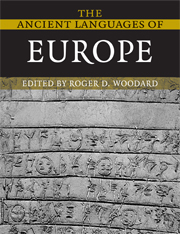Book contents
- Frontmatter
- Contents
- List of figures
- List of tables
- List of maps
- List of contributors
- Notes on numbering and cross-referencing
- List of abbreviations
- Preface
- Preface to the first edition
- 1 Language in ancient Europe: an introduction
- 2 Attic Greek
- 3 Greek dialects
- 4 Latin
- 5 Sabellian languages
- 6 Venetic
- 7 Etruscan
- 8 Continental Celtic
- 9 Gothic
- 10 Ancient Nordic
- Appendix 1 Indo-European
- Appendix 2 Full tables of contents from The Cambridge Encyclopedia of the World's Ancient Languages, and from the other volumes in the paperback series
- Index of general subjects
- Index of grammar and linguistics
- Index of languages
- Index of named linguistic laws and principles
Appendix 1 - Indo-European
Published online by Cambridge University Press: 01 September 2010
- Frontmatter
- Contents
- List of figures
- List of tables
- List of maps
- List of contributors
- Notes on numbering and cross-referencing
- List of abbreviations
- Preface
- Preface to the first edition
- 1 Language in ancient Europe: an introduction
- 2 Attic Greek
- 3 Greek dialects
- 4 Latin
- 5 Sabellian languages
- 6 Venetic
- 7 Etruscan
- 8 Continental Celtic
- 9 Gothic
- 10 Ancient Nordic
- Appendix 1 Indo-European
- Appendix 2 Full tables of contents from The Cambridge Encyclopedia of the World's Ancient Languages, and from the other volumes in the paperback series
- Index of general subjects
- Index of grammar and linguistics
- Index of languages
- Index of named linguistic laws and principles
Summary
THEORETICAL AND HISTORICAL CONTEXTS
The comparative method
The parent language of the Indo-European linguistic family is an “ancient” language in a special sense: it is a protolanguage, not attested but reconstructed. Since a protolanguage is, broadly speaking, the collection of all retentions in the daughter languages, the ability to segregate innovation from retention in the latter is crucial for the reconstruction of the former. The “comparative” method (in the narrow, phonological sense of the term) accomplishes that segregation to a large extent (on the comparative method of historical linguistics, see also WAL Ch. 45). Those innovations which we classify as sound-changes are capable of producing homophony among morphs; they are phonemic mergers, with the algebraic form /a/ > /m/, /b/ > /m/ (further elaboration is needed for conditioned sound-changes). Owing to the “Polivanov” property of sound changes (“no split without merger”), which follows from their definition as replacements statable in purely phonological terms (without reference, that is, to particular morphs), it is the case that if one phoneme, or one phonemic component (distinctive feature specification), or one phoneme combination (diphthong, cluster, syllable, etc.) in language A corresponds to one phoneme or phonemic component or phoneme combination in a related language B in one set of morphs, and to some other phoneme (etc.) in another set of morphs, then language A has in this detail innovated.
- Type
- Chapter
- Information
- The Ancient Languages of Europe , pp. 230 - 246Publisher: Cambridge University PressPrint publication year: 2008
- 1
- Cited by



